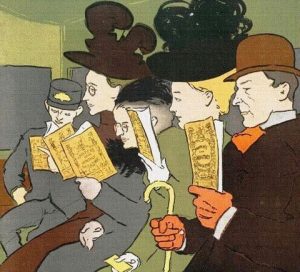 In Virginia Woolf’s short story “An Unwritten Novel,” there are two parallel stories: first, there is the “real” story, which follows a passenger on a train who becomes fascinated by the older woman riding across from her. This woman seems unhappy, and instead of smoking, reading the newspaper, or in any way trying to conceal her discomfort, she simply sits and stares straight ahead of her. The two make a little small talk and the woman mentions her sister-in-law, who she calls a cow. When they reach their destination the older woman meets her son there and departs with him. The second story is the one which takes precedence over the other, and it is the story that the narrator makes up in her mind about the other woman’s life in order to explain her demeanor.
In Virginia Woolf’s short story “An Unwritten Novel,” there are two parallel stories: first, there is the “real” story, which follows a passenger on a train who becomes fascinated by the older woman riding across from her. This woman seems unhappy, and instead of smoking, reading the newspaper, or in any way trying to conceal her discomfort, she simply sits and stares straight ahead of her. The two make a little small talk and the woman mentions her sister-in-law, who she calls a cow. When they reach their destination the older woman meets her son there and departs with him. The second story is the one which takes precedence over the other, and it is the story that the narrator makes up in her mind about the other woman’s life in order to explain her demeanor.
In this story, the woman is arbitrarily named “Minnie Marsh.” She is unmarried and childless, and reluctantly traveling to stay with her sister-in-law, “Hilda.” There is a man that Minnie loves, named “James Moggridge,” a button salesman. The narrator imagines that the cause of Minnie’s somber expression is that she has committed some crime in her past which she still carries the guilt for. After some brainstorming, she determines that this crime was negligence while looking after her baby brother – she put the kettle on and left him unattended, and he tipped it over and died from the boiling water. The narrator becomes so engrossed in this version of the woman’s life that, when they reach the train station and the woman is met by a son that the narrator had not envisioned, she grows momentarily confused and upset. However, she is very quickly wrapped up in the possibilities that this son has created, and she is again flooded with wonder at the world and the people in it. She says:
“Off they go, down the road, side by side…. Well, my world’s done for! What do I stand on? What do I know? That’s not Minnie. There never was Moggridge. Who am I? Life’s bare as bone.
And yet the last look of them – he stepping from the kerb and she following him round the edge of the big building brims me with wonder – floods me anew. Mysterious figures! Mother and son. Who are you? Why do you walk down the street? Where tonight will you sleep, and then, tomorrow? Oh, how it whirls and surges – floats me afresh!”
This story effectively captures the feeling of sonder that many writers experience, and often use as inspiration for their writing. It is titled “An Unwritten Novel” because the story invented by the narrator may have later become a novel, were it not for the forced shift in perspective that she was met with at the end. There is an unwritten novel for every person alive, and this narrator is easily wrapped up in these fictional lives, even to the point that she can lose track of reality. She sees a full life behind every person she passes, and she is infinitely curious. In the very first paragraph she expresses this wonder, saying: “life’s what you see in people’s eyes; life’s what they learn, and, having learnt it, never, though they seek to hide it, cease to be aware of – what?” This is a good quality in a writer, as it marks not only a high level of creativity, but the empathy which is what makes a story feel authentic.